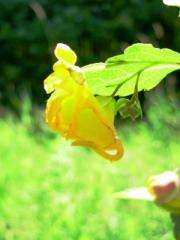Researcher Studies How Flowers Fight Back Against Damaging Insect Visitors

Though summer's flowers appear delicate and carefree to us, in fact plants must be tough enough to defend their blossoms against antagonists including florivores and nectar robbers, that is, insects who eat, steal or destroy nectar and flowers without performing beneficial pollination services.
Many plants use toxic chemicals and other strategies to stop or punish marauding insects from threatening their flowers, according to doctoral student Nicole Soper Gorden in plant, soil and insect sciences. She recently received a $14,998 National Science Foundation dissertation grant to bring new methods to the investigation of how flowers defend themselves against nectar robbers and florivores and explore how they interact with beneficial pollinators such as bees, to assure reproductive success.
Only 12 such grants were funded nationwide from 140 applications, a compliment to the significance of Soper Gorden's research topic and recognition of her skills in plant tissue chemical analysis. She is the first to use advanced chemical analysis to study the woodland flower Spotted Touch-me-not, Impatiens capensis, also known as jewelweed.
Chemical defenses in plant leaves have been well studied, but that's not true for flowers, Soper Gorden explains. Many nectars contain alkaloids and phenolics to deter pests, and flower petals can contain the same chemical defenses as leaves. She is investigating in detail how plants defend not only their leaves but their blooms.
"Flowers are closely linked with plant fitness and floral defensive compounds are common, so understanding the role of floral chemistry mediating interactions is essential," she says. "Pollinators are estimated to provide $100 billion in services each year, and insects that damage flowers can devastate crops, carry diseases, cause invasions or act as biological control agents. Understanding how floral competitors interact with one another and their host plants is critical for managing crop yield and species diversity."
Flowers face a surprising variety of antagonists. For example, some bees cut holes in blooms to steal nectar, while other bee species, flies and ants steal nectar without damaging the blossom. Beetles, including the gardener's nemesis, the Japanese beetle, are florivores, which means they eat the entire flower and are not interested in the nectar. This summer and next, Soper Gorden is observing interactions between these pests and jewelweed and conducting experiments with insect visitors in garden plots at the nearby Hampshire College farm.
Right now, Soper Gorden and three undergraduate assistants are collecting nectar, flowers and leaves and counting numbers of insect visitors by species interacting with 200 plants in the experimental garden. They're assessing pollination in 15-minute sessions once per week, recording the number of flowers visited and time per flower as well as visiting numbers of nectar robbers, thieves, florivores and flower-galling insects.
Further, she's looking at numbers of fruits, seeds per fruit, seed mass and percent germination as markers of reproductive success. In the laboratory, Soper Gorden is measuring anthocyanins, condensed tannins, nectar production and sugar composition using spectrophotometry and high performance liquid chromatography.
Next summer, the young researcher will set up an array of 160 jewelweed plants at Hampshire Farm and use three treatments which manipulate pollinators, nectar robbers and florivores to compare groups under the three manipulated conditions, under all possible combinations of the three, plus a control group with no treatments.
One treatment involves hand-pollination to increase pollination success. For a second, Soper Gorden will simulate nectar robbing by cutting a small hole near the flower's spur, where nectar robbers typically do the same, and removing nectar. Finally, she'll simulate florivory by allowing Japanese beetles to eat approximately 50 percent of floral tissue. Reproductive and other measures will be compared to a control group with no manipulations.
"We'll use these data to model how all the insects interact with each other and the plant, as well as the plant's defenses and its nectar rewards, to better understand the flower's role and the overall implications for plant reproduction," she summarizes.
Provided by University of Massachusetts Amherst



















